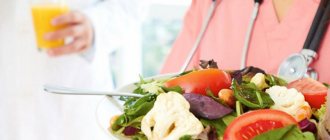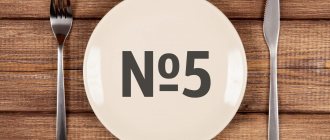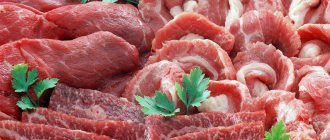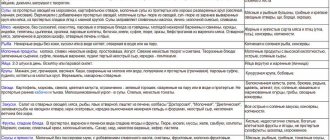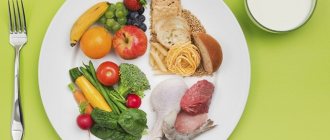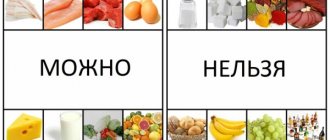Diet table 9 is prescribed for type 2 diabetes mellitus, less often type 1. The purpose of this diet is to balance the amount of substances a person consumes and stabilize insulin production.
In addition to type 2 diabetes, such nutrition can be prescribed for many other diseases that are not related to insulin stabilization. Diet 9 is also prescribed for allergies, urticaria, rheumatism and polyarthritis, and bronchial asthma. Depending on the disease and its severity, the doctor regulates the patient’s nutrition according to the diet rules.
Diet number 9 for diabetics
In some countries, diet table number 9 is traditionally used for the treatment and prevention of diabetes. It can be prescribed for mild to moderate diabetes mellitus in the absence of concomitant diseases of internal organs and acidosis. With this nutritional system, the protein content exceeds the physiological norm, but the amount of carbohydrates and fats (mainly animals) is moderately limited. Easily digestible carbohydrates are excluded. The diet contains substances that have a lipotropic effect.
The diet should contain a lot of vegetables. Cholesterol-rich foods and salt are limited when following the diet table number nine. Sweets and sugar are practically excluded - the exact norm is regulated by the attending physician. Instead of sugar, artificial and natural substitutes are used. Mostly food is consumed baked or boiled. Fried or stewed foods are allowed on the table. The food temperature is normal.
The diet involves 5-6 meals per day. Carbohydrates are distributed in equal portions throughout the day. Such a nutritional system prevents lipid metabolism disorders, helps normalize carbohydrate metabolism, and helps determine carbohydrate tolerance.
Content:
Basic principles of dietary table No. 9
Sugar and other easily digestible carbohydrates are completely excluded from the diet. Cooking fats such as margarine and spreads with hydrogenated vegetable oils are contraindicated. Animal fats are limited. The amount of salt, foods high in cholesterol, and extractives is slightly reduced.
Preference should be given to products that contain a lot of natural fiber: vegetables and fruits, with the exception of those that contain pure glucose (grapes, figs). Pasta and bread should be made from whole grain flour, preferably with the addition of bran.
If we translate these recommendations into the language of modern dietetics, we get the following:
- “fast” carbohydrates are completely excluded;
- Most of the diet should contain foods with a low glycemic index; they do not cause “jumps” in blood glucose levels;
- vegetable fats are preferable to animal fats.
You can find out the glycemic index of foods from special tables that are widely distributed on the Internet.
Diet No. 9 for diabetics: what is possible, what is not?
While following the diet, the following foods are allowed:
- Unsweetened compotes using sugar substitutes, juices from unsweetened fruits, vegetables and berries, coffee with milk, rosehip decoction.
- Flour non-food products, wheat, protein-wheat, rye bread made from second-grade flour. The daily norm is about 300 g.
- Unsalted ghee and butter.
- Low-fat and half-fat cottage cheese, unsalted cheese, fermented milk products and milk, sour cream in small quantities.
- Lean meat.
- Canned fish in tomato or its own juice, low-fat fish.
- Eggs in the form of omelettes or soft-boiled (one or two eggs per day).
- Low-fat sauces based on weak mushroom, fish and meat broths.
- Porridges made from pearl barley, oatmeal, barley, millet and buckwheat.
- Cooked and raw vegetables - legumes, eggplants, cabbage, lettuce, tomatoes, cucumbers. In limited quantities carrots, beets, green peas, potatoes.
Prohibited for use:
- Cakes, puff pastry and pastry products.
- Sweet curd cheeses, cream, salty cheeses.
- Fatty, strong broths.
- Milk soups with noodles, rice, semolina.
- Sausages, sausages, smoked meats.
- Cooking and animal fats, pickled and salted vegetables.
- Dates, figs, bananas, raisins, grapes.
- Ice cream, sweets, jam.
- Sweet juices, lemonades and sparkling waters with sugar.
- Alcoholic drinks.
List of prohibited products
- Quickly digestible carbohydrates: Confectionery products, flour.
- From fruits and vegetables: grapes, dates, beets and carrots, bananas and pears.
- Drinks: syrups, grape juice.
- From porridges: semolina and rice.
- Dairy: milk soups with cereals, sweet curds and cream.
- Broths and fatty meats. All kinds of canned food, sausages, salted and smoked fish, as well as caviar.
- Canned food, salty, spicy, sour.
- The sauces are spicy and salty.
Diet menu No. 9 for the week
An approximate daily diet for diet table number nine might look like this:
- First breakfast - tea, crumbly buckwheat porridge, low-fat cottage cheese with milk.
- Second breakfast is a decoction of wheat bran.
- Lunch – vegetarian cabbage soup made from fresh cabbage with vegetable oil, stewed carrots, boiled meat with milk sauce.
- Afternoon snack – fresh apples.
- Dinner – boiled fish baked in milk sauce, tea, cabbage schnitzel.
- Kefir before bed.
Sample weekly diet:
| Days of the week | Meal time | Name of dishes |
| First | Breakfast | Cottage cheese with berries (low fat) |
| Lunch | A glass of kefir | |
| Dinner | Stewed vegetables, baked lamb, vegetable soup | |
| Afternoon snack | Cucumber and cabbage salad with olive oil | |
| Dinner | Steamed vegetables, grilled fish | |
| Second | Breakfast | Buckwheat porridge with milk |
| Lunch | A couple of apples (green) | |
| Dinner | Compote of dried fruits without added sugar, boiled beef, borscht without meat | |
| Afternoon snack | Rose hip decoction | |
| Dinner | Fresh vegetables, boiled fish | |
| Third | Breakfast | Cottage cheese casserole |
| Lunch | Rosehip decoction (fruit) | |
| Dinner | Fresh vegetables, fish cutlets, cabbage soup (without adding meat) from fresh cabbage | |
| Afternoon snack | Boiled egg | |
| Dinner | Stewed cabbage, steamed meat cutlets | |
| Fourth | Breakfast | Vegetables and omelet |
| Lunch | Drinking yoghurt | |
| Dinner | Stuffed peppers, cream of broccoli soup | |
| Afternoon snack | Carrot casserole with cottage cheese | |
| Dinner | Grilled vegetables, chicken kebab | |
| Fifth | Breakfast | Apple, millet porridge |
| Lunch | A couple of oranges | |
| Dinner | Pearl barley porridge, meat goulash, fish soup | |
| Afternoon snack | Bran, a glass of kefir | |
| Dinner | Baked asparagus, buckwheat porridge, meat cutlets | |
| Sixth | Breakfast | Apple, bran |
| Lunch | Boiled egg | |
| Dinner | Vegetable stew with pieces of meat | |
| Afternoon snack | Celery stalk and tomato salad | |
| Dinner | Lamb stewed with vegetables | |
| Seventh | Breakfast | Yogurt and cottage cheese (low fat) |
| Lunch | Grilled chicken breast | |
| Dinner | Apple and celery stalk salad, meat goulash, vegetable soup | |
| Afternoon snack | Berries | |
| Dinner | Steamed green beans, boiled shrimp |
It is necessary to exclude everything fried, spicy, salty and smoked from the diet. Diet table No. 9 is prescribed and regulated by a doctor.
Patient reviews
According to reviews, the first weeks on a diet are the most difficult. Then the taste of dietary dishes is revealed. I don’t want anything salty, fried or sweet at all.
The therapeutic diet has a visible effect during pregnancy. Many women and doctors believe that following the rules of the ninth table of diabetics leads to an easier birth.
Patients confirm an improvement in overall well-being and restoration of the gastrointestinal tract. They say that blood sugar levels actually decrease. In addition, this is a great way to lose weight. On the 9 table diet you can lose up to 1-2 kg per week. The main thing is to maintain the correct amounts of food and keep a food diary.
Medical nutrition is praised for the availability of products. It also has other advantages:
- balanced diet;
- budget products;
- many food options;
- without fasting:
- normalization of cholesterol levels;
- allows you to adjust your figure.
Disadvantages include the need for frequent cooking and calorie counting.
Diet recipes No. 9
Pike perch in Tatar style.
Ingredients: 5 g parsley, half a lemon, 10 g olives, 5 g capers, 30 g sour cream, 50 g onions, 30 ml olive oil, 150 g pike perch. Pour olive oil into the bottom of the pan and place the fish pieces. Pour the onion juice over the pike perch, cover the pan and place in the oven. After the fish has warmed up, pour sour cream over it and cook over low heat. Add lemon, olives, capers, stir, simmer for a while and serve with chopped parsley.
Cod with lemon juice
. Ingredients: 20 g green onions, 10 g parsley, 1/3 lemon, 30 ml olive oil, 150 g cod. Soak the cod in water for 24 hours, peel and cook. Drain the water, put the cod in a pan, add salt, onion, parsley, olive oil. After the fish is soaked in oil, pour a little lemon juice over it and cook over low heat for 20-25 minutes.
Useful tips
The following should be remembered:
- When combining permitted foods, you should remember that most of the diet should consist of vegetables and fruits. During pregnancy, meat and poultry are needed every day, especially during pregnancy complicated by diabetes, so there is no place for separate mono-diets and vegetarianism.
- Try not to skip meals. Get several food containers and place portions in them for all meals for the coming day. This will make it easier, especially if the woman works or studies. Even at work or during breaks between lectures, you should find time to eat the prescribed portion.
- When cooking, use easy-to-make recipes . This will save time and provide the expectant mother and her baby with everything they need. Such simple dishes include buckwheat porridge with water, boiled pollock, and stewed pieces of beef. Avoid exotic foods (fruits and fish), as well as spices. Of all the spices, only a small amount of dill (in soup or salad) or parsley is permissible for a pregnant woman with diabetes mellitus or gestational diabetes.
- A woman should completely avoid mayonnaise, mustard, vinegar, ready-made sauces, and ketchup. Natural coffee and cocoa are also completely prohibited. If you want to season the dish with something, use low-fat sour cream and your own ingenuity. It can be mixed with finely chopped dill or grated sour apple.
Very soon you will become confident that homemade sauces are not only healthy, but also very tasty.
In the next video, see a sample menu for the week and recipes for dietary dishes for the “table No. 9” diet.
medical reviewer, psychosomatics specialist, mother of 4 children
Diet No. 9 for children
For children with diabetes, six meals a day are provided hourly. Deviations from the meal schedule should not be more than 10-20 minutes. Products containing slowly and difficult to digest carbohydrates are introduced into the diet. When preparing mousses, compotes and jellies, you can use sugar substitutes. Children have a hard time accepting the complete absence of sweets, so the use of fructose is recommended. In agreement with the doctor, the child can be transferred to an adult diet corresponding to the diet of table number nine.
Author of the article:
Kuzmina Vera Valerievna |
Endocrinologist, nutritionist Education: Diploma of the Russian State Medical University named after. N.I. Pirogov, specialty “General Medicine” (2004). Residency at the Moscow State Medical and Dental University, diploma in Endocrinology (2006). Our authors
Diet varieties
Diet 9 for diabetes is intended to be followed throughout life.
Depending on the patient’s condition and the rate of progression of the pathology, the therapeutic diet comes in two varieties:
- 9A. Recommended at the initial stage of the disease for patients with excessive body weight and lack of insulin dependence.
- 9B. Designed for diabetics with a progressive insulin-dependent form of the disease. It differs from the first variety in its increased carbohydrate content.
People who follow both types of therapeutic diets need to regularly monitor their glucose levels.


